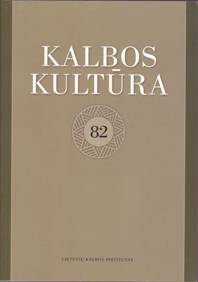Author(s): Aldonas Pupkis / Language(s): Lithuanian
Issue: 89/2016
The article deals with one of the issues of the adaptation of loanwords in the Lithuanian language – marking the stress on syllables and the systemic correlation between stressed syllables of borrowed words. It shows the relationship between the history of the marking and the present accentuation that is connected with an important requirement of Lithuanian accentology that the so-called Saussure-Fortunatov law has to be applied according to the quality of a stressed syllable.In books on Lithuanian accentology and lexicography the most frequent accent on syllables in the words of foreign origin was the circumflex, rarer the acute since th beginning of the present science of accentology. Jonas Jablonskis, later linguists Pranas Skardžius and Antanas Salys consolidated this model of accentuation. Words with the semidiphthongs and diphthongs el, er, em, en, eu, ei were accentuated in this way by the famous lexicographers Benjaminas Sereiskis and Jonas Baronas as well as the 1948 Lietuvių kalbos rašybos žodynas (Dictionary of Lithuanian Spelling) among others. However, in the 1951 Dictionary of International Words a real ‘revolution’ in this accentuation was carried out without any discussion and public consultations: words with the semi-diphthongs el, er and diphthong eu in the stressed syllables everywhere carried the grave. In this way in Lithuanian accentology, a two-way (grave and acute) accentual representation of words with the falling syllable accent of semi-diphthongs èl, èr : él, ér and diphthong èu : éu appeared. This accentuation pattern is not only different from the entire accentual system of semidiphthongs of Standard Lithuanian (it does not exist in the dialects either), but also stimulates the phenomenon of stress shift, which is not characteristic of the language users for whom this stress realisation model is strange.The article demonstrates this type of grave in these semi-diphthongs and diphthong eu is of foreign origin and requires the recognition of the existence of the phoneme /ẹ/ in standard language, which appears only in words of foreign origin. In reality, the vowels, which are represented by this false phoneme and appear in the speech of some language users does not perform a distinctive function creating chaos in the accentual system of semidiphthongs. Therefore, this vowel [ẹ] used in words of foreign origin should be considered only as a variant of the phoneme /e/. This was underlined by the opponents of the 1951 accentuation revolution, Antanas Salys, Adelė Laigonaitė, Aleksas Girdenis and others.In the conclusions of the article, based on the originality of Lithuanian language prosody and the practice of marking the stress of other semi-diphthongs and diphthongs (em, en, ei) as well as the data of real usage, it is suggested returning to the long-time practice of marking stress in words of foreign origin introduced by Jablonskis, i.e. in books on accentology, school books, dictionaries, encyclopaedias and elsewhere, the stress èl, èr, èu used until now should be replaced by the pronunciation that corresponds to usage and mark e, e, eũ or, if necessary, take into account other circumstances and mark él, ér, éu. The technical aspect of this issue is not a matter the language science.
More...

